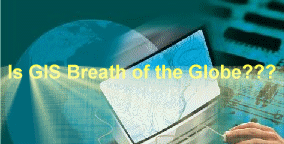In the present developed and developing
societies in our globe Geographical Information System has become a breath,
and is being used in all the fields from cycle route planning to aviation
networking, modeling the natural phenomena on the earth to space modeling.
Geographical Information System, a tool in which one can store all
the information about the earth surface, weather it is natural or man
made. The stored information can be modified and retrieved and obtain
the answers for the questions raised by us for the welfare of the society
and sustainable development of the natural resources of our earth.
What is Special about GIS
The uniqueness of GIS is its ability to store the linkage between the
spatial and non spatial data and enables to retrieve and manipulate the
data to find the answers to the questions on the real world. In the present
society GIS is potentially used and widely accepted by the experts of different
fields to manage the society and the natural resources of the earth surface.
Generally the data is stored as layers in the geographic information system
and once the data is stored in GIS database, it is possible to perform
complex analysis.
Though the GIS technology was primarily used to map the natural resources
of the earth surface in early 60’s, now the GIS is used in interdisciplinary
research. Some of the applications are as follows;
Though
the above are some of the applications of GIS, this powerful technology
is being widely used in military applications. It is nevertheless
to say that GIS technology is being used in almost every field which has
geographic relevance at any point of time.
Other potential fields in which GIS can be applied are Academic, Agriculture,
Business, Environment, Natural Resource Management, Social Science, Transportation
and urban planning, Water Resources and military applications.
How does a GIS work?
GIS works by relating different information in a spatial context, having
the address or location reference. When information about the rainfall
is collected and stored in GIS system, it is very important to know the
location or address of the rain gauge station from which the data has been
collected.
The location reference may be
geographical latitude/longitude or UTM coordinates. This rainfall
information can be compared with other features like watersheds, landscape
and one can infer new information weather the watershed and the landscape
are receiving sufficient rainfall or not, which is useful for decision-making.
|

Input for GIS
The main source of input for GIS analysis is Satellite data, which gives repetitive information about the same area of the earth at certain intervals. This information can be useful to update the GIS data base frequently which helps in giving accurate results. Other sources of data are aerial photographs, topsheets, old records and maps available with the government organizations which can be scanned and input to GIS and Global position System from which one can get the data with location accuracy. Data Capture, Data integration, projections and integrations, data modeling and data structures are some of the important modules to be learnt and implemented for successful implementation of GIS in any field of interest. Information retrieval How many number of school going
children are there within the radius of 2 km of your own school? This
kind of information can be retrieved easily from your GIS database by
using the special retrieval function called neighborhood function.
The kind of information, How many medical shops are there within a distance
of 5 km from a Hospital? can be useful to establish a new medical
shop.
NetworksTopological modeling Are there any gas stations near the school ? How many fire stations are there around the gas station? What is the slope, runoff and soil loss in the watershed? Answer for the above questions can be given by GIS by the module topological modeling. A GIS can recognize and analyze the spatial relationships among mapped phenomena. Conditions of adjacency (what is next to what), containment (what is enclosed by what), and proximity (how close something is to something else) can be determined with a GIS. When there is a severe rainfall
in the upstream of a catchments, it is important to understand how much
time will it take to the flood to inundate the villages in the downstream
of the catchments? And what is the severity of the flood?. This is done
by using a linear network. It allows the computer to determine how the water
is traveling to the downstream. The answers for the above questions are
very useful and important to take immediate action to ejaculate dwellers
in those villages under threat. The information on the volume of water,
velocity of flow and speed throughout the spatial network can help the GIS
determine how long it will take to travel downstream. Network analysis
can also be used to understand the shortest distance to drop the perishable
goods from one place to the other.
OverlayThe buzzing word in GIS is map
overlay techniques. Using maps of rainfall, soil, hydrogeology,
geology, land use/land cover, geomorphology, and slope the GIS might produce
a new map layer or overlay that ranks the given area according to their
potential to explore the groundwater.
Data outputThe most important and critical
component of a GIS is its ability to produce graphics on the screen or
on paper to convey the results of analyses to the people who make decisions
about resources. One can produce more impressive and easily understandable
paper maps, internet maps, interactive maps from which the decision makers
can easily visualize and understand the results of the analyses performed
by the expert by using GIS technology.
ReferencesNow a days GIS technology is widely used to simulate the real world phenomena for sustainable development of natural resources of the Globe and GIS has become breath of the present society. Chor Pang Lo, Albert K.W. Yeung, Concepts and Techniques of Geographic Information Systems (2nd Edition), Ph Series in Geographic Information Science. www.erg.usgs.gov, Website of U.S. Department of the Interior, U.S. Geological Survey, (accessed on Oct. 11’ 2006). |
||||||
